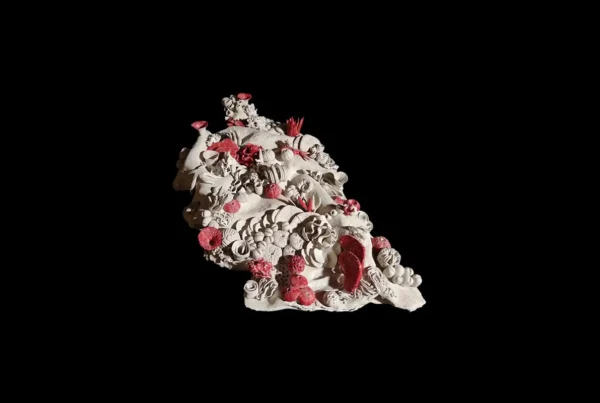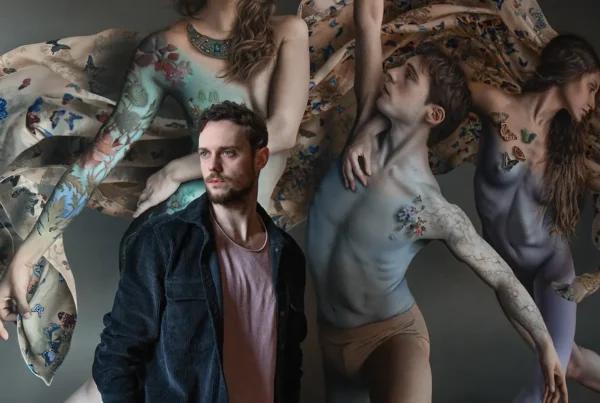“I see here a very inspiring duality: they can be opposites to each other: like one is yes the other is no, but also they can be collateral.”

Linda Bodolóczki, the artist.
Early Inspirations and Emotional Landscapes
From the humble beginnings in a Northern Hungarian village, Linda Bodolóczki‘s (@lindabodoloczki) journey into the art world was marked by personal exploration and emotional expressions that finally led her to become a graduate of the Hungarian University of Fine Arts. By the age of eight, Linda was meticulously copying illustrations from children’s books, striving for perfection until her drawings mirrored those of the original artists. This relentless pursuit of accuracy was perhaps her earliest encounter with the discipline required for art. However, it was her emotional experiences that truly colored her canvases. At twelve, faced with the pangs of unrequited love, Linda ventured into abstract painting, depicting her broken heart—a bold move that even embarrassed her drawing teacher. These early experiences underscore how deeply interwoven her emotions are with her art, setting a precedent for her lifelong artistic endeavors.
Linda’s art remained a private refuge as she navigated her formative years, opting not to attend drawing school for fear of critical rejection that might shatter her passion. Instead, she embarked on a career in journalism, keeping her artistic flame alive in the shadows until a pivotal moment at age 23. Encouraged by a drawing school teacher, Linda took the brave step of applying to the Hungarian University of Fine Arts. Her acceptance into the university marked a significant turning point, not just academically but in the affirmation it provided—that her art, her personal sanctuary of expression, held broader appeal and significance. This affirmation fueled her transition from journalism to becoming a full-time artist, though not without a seven-year hiatus in scriptwriting that paused her artistic output but perhaps enriched her narrative depth.
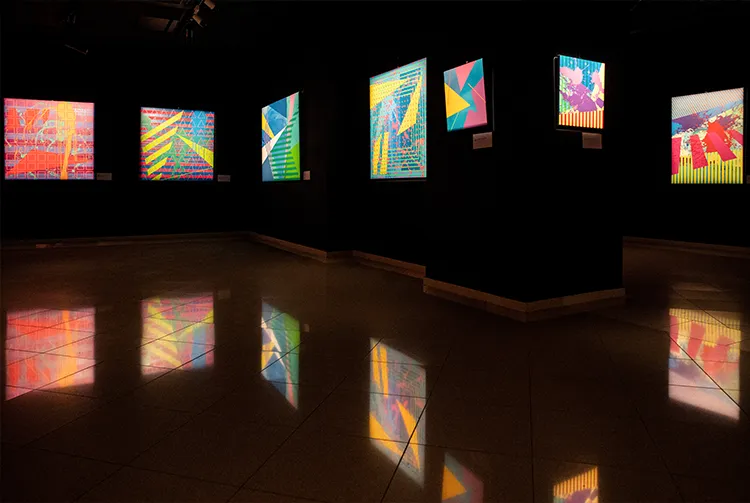
Exhibition at Virág Judit Gallery, one of the biggest galleries of Hungary, 2023. Photo: Eszter Gordon
Linda Bodolóczki: The Artist’s Metamorphosis
The transition from bustling city life of Budapest, capital of Hungary, to the serene Balaton Uplands provided Linda Bodolóczki with both challenges and new artistic inspirations. This change of scenery was crucial as she embraced her surroundings to inform her evolving artistic style. Initially, Linda captured the scenic beauty of her new home through sketches, which she then abstracted in her studio. Her technique involved distilling these landscapes into basic contours filled with a medley of gestures, stripes, dots, and geometric forms. This method not only allowed her to process her mixed emotions about the move—her happiness to be closer to nature against her fears of cultural and social isolation—but also led to a significant stylistic evolution: the abstraction of landscapes into non-figurative art.
Her artistic exploration did not stop with mere abstraction. Linda saw in the dual use of geometry and gesture an intriguing dialogue between control and spontaneity, order and chaos. These elements symbolized for her the layers of human personality—the controlled versus the uncontrollable. Her canvases became battlefields where these opposites clashed and danced, each layer of paint not fully concealing the previous, symbolically like how past experiences leave indelible marks on individuals. This interplay of techniques not only represented her internal conflicts but also mirrored the broader human condition, making her work universally resonant and profoundly introspective.
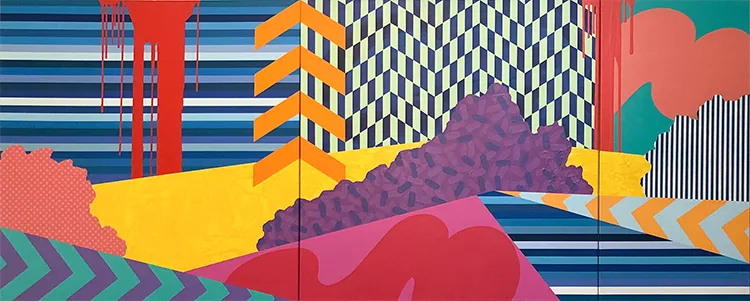
On the Way to Monoszló, acrylic on canvas, 250×100 cm, 2021.
Navigating Contemporary Challenges
As the world around us shifted dramatically, so did Linda Bodolóczki’s artistic focus. The onset of a global pandemic, escalating political tensions, and the looming threat of climate change profoundly impacted her perspective and, consequently, her artwork. Linda’s response was to transition from her previous abstracts referring to personality layers to more fragmented and chaotic compositions, reflecting the overwhelming sense of global disarray. These new works featured separated fields within each painting, each representing different facets of chaos and control—geometry symbolizing the world’s vain attempts for order, and gestural techniques depicting the spontaneous and uncontrollable aspects of life. This stylistic evolution marked a shift in Linda’s thematic focus from internal emotional landscapes to a broader commentary on the external world’s tumult.
Art historian Zsolt Mészáros has remarked on the dynamic interplay within Linda’s compositions, suggesting they resemble “multiple channeled videos.” This comparison highlights the active, almost cinematic quality of her work, where viewers are encouraged to explore various narratives within a single frame, never fully settling, always searching. This technique challenges the viewer to either piece together a coherent whole from the disparate parts or to accept the lack of cohesion as a reflection of current global realities. Such is the power of Linda’s art—it not only captures visual aesthetics but also invites deep reflection on the state of the world, echoing the chaos that seems pervasive in every aspect of modern life.
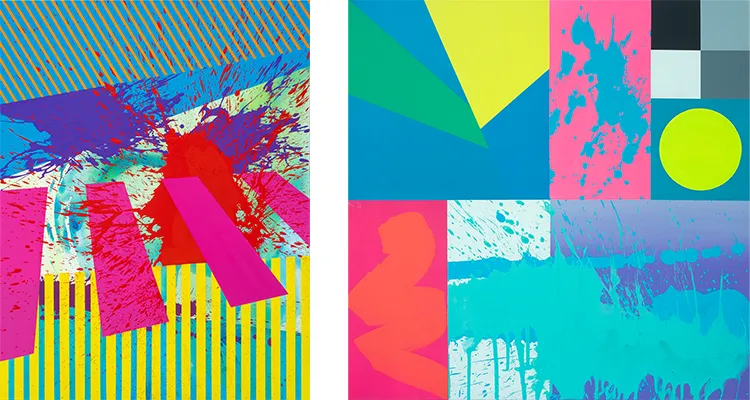
A-023, acrylic on canvas, 130×100 cm, 2021, and P-001, acrylic on canvas, 90×90 cm, 2024.
Linda Bodolóczki: Pop Art’s Vibrancy and Personal Rituals
Linda Bodolóczki’s artistic influences and practices offer a glimpse into the mechanics of her creativity and the personal significance of her work. Deeply influenced by the pop art movement, she adopts its hallmark vibrant colors and use of contrast to express intense emotions and highlight critical elements of her compositions. Pop artists’ employment of billboard techniques, with their bold simplicity and visual impact, resonates deeply with Linda, informing her approach to both color and form. This influence is particularly evident in her adoption of vivid color schemes that enhance the emotional expressiveness of her paintings, making each piece a vivid declaration of feeling.
While working, chaos reigns in her workspace. Tons of original and self-mixed paints occupy the shelves and tables, alongside self-made thin cardboard boxes used to protect other paintings from splashes. A microphone stand holds a hair-dryer above the painting to expedite drying, while an array of rulers, lasers, and dozens of masking tapes reflect her need for order amid the creative chaos. Once a piece is completed, the studio is tidied, only for chaos to rise again as the next canvas takes its place. This intimate setting is where Linda’s theories and techniques coalesce into tangible art.
Her process is uniquely adapted to accommodate the rhythms of her life. Gestures and splashes represent the intuitive, spontaneous events and emotions that lead to emotional highs and lows, while geometric elements signify the planned and focused aspects of life. Recently, she has felt an urge to incorporate meditative surfaces into her paintings, providing moments of pause. These surfaces allow Linda to immerse herself in a magical world of colors, reflecting her life away from the noise of civilization and the “slow-life” experience in the countryside. She dots thousands of vibrant specks on the canvas, creating a mesmerizing optical effect that invites viewers into a meditative space, much like the artist herself during the creation process. Art historian Brigitta Muladi has commented on these dotted surfaces, seeing them as metaphors for the overwhelming, incessant demands of modern life that allow no respite, yet in Linda’s treatment, they offer a visual pause, a moment of contemplative silence amid the noise.
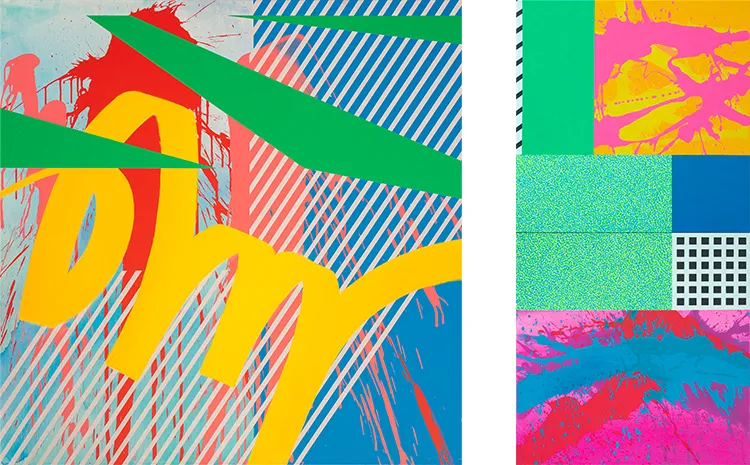
A-044, acrylic on canvas, 120×120 cm, 2022, and P-012, acrylic on canvas, 140×70 cm, 2024.




